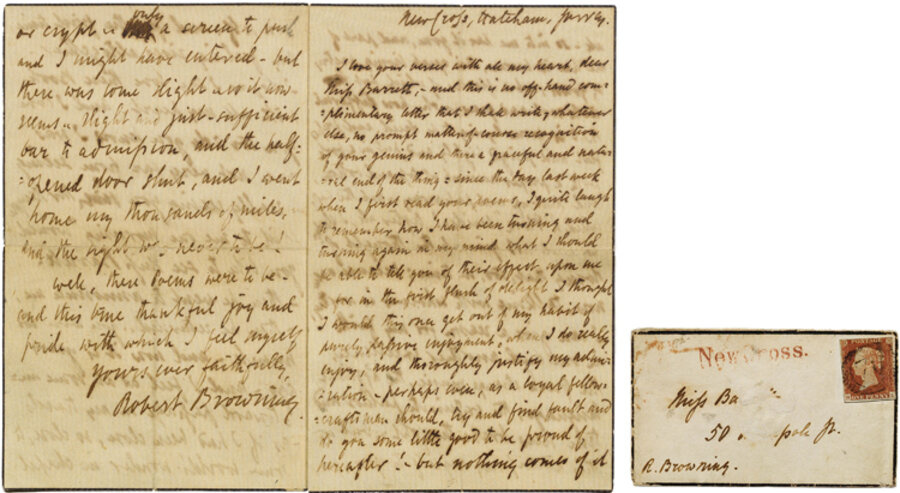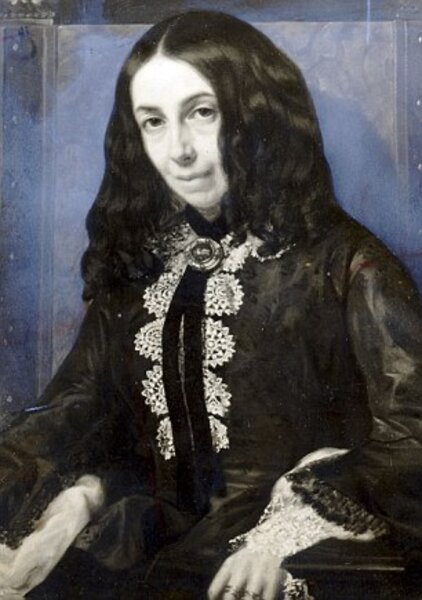Barrett-Browning love letters go digital
Loading...
The eminent 18th-century English literary critic and polymath Samuel Johnson once wrote, "There is, indeed, no transaction which offers stronger temptations to fallacy and sophistication than epistolary intercourse." Had Johnson lived long enough to read the correspondence between Elizabeth Barrett and Robert Browning, he might not have been so quick to decry the art of letter writing. This Valentine’s Day, the courtship letters of two of the most famous Victorian poets were made publicly available online. Suffused with ardent intimacy and candor, the letters not only afford readers a glimpse into the Browning’s burgeoning romance, but also illuminate their views on each other’s aesthetics as well as contemporary affairs.
The Browning love letters, totaling 573, are housed in the Margaret Clapp Special Collections of Wellesley College in Massachusetts, and have been uploaded to the massive digital collection of Browning letters at the Armstrong Browning Library of Baylor University in Texas. According to a press release from Wellesley College, the event marks "the largest digitization effort of love letters ever undertaken." Students, scholars, and poetry enthusiasts alike can now view transcriptions of the letters as well as high-resolution images of the handwritten missives and corresponding envelopes. In addition to zoom and rotate functions, a search feature allows users to locate keywords in each of the letters.
The collaboration between Baylor University and Wellesley College grew out of a shared desire to preserve the original Browning letters and to increase the public’s access to these revelatory documents. Ruth Rogers, Wellesley’s Curator of Special Collections said, "Wellesley College is indeed fortunate to have the originals, but we should not ‘possess’ them – their heritage is international."
Leslie Brisman, the Karl Young Professor of English at Yale University, reflected: "Every digitization project that makes accessible texts of, or texts related to, important writers is an occasion for applause. But there is something extra special about the digitization of correspondence between one of the greatest and one of the most popular of poets: the project itself invites us to do something almost oxymoronic – think more profoundly about the very idea of 'the popular.'"
According to Wellesley College archivist Ian Graham, "The project was first discussed between Baylor and Wellesley several years ago, but did not begin in earnest until last March. Once the commitment between Baylor and Wellesley was made, the entire project took eleven months." Graham further commented that the collaboration with Baylor, the world's largest repository of Browning resources, “has been fantastic and professional every step of the way. The interests of the two institutions are so closely aligned in making the Browning materials available that the project has been more a labor of love than anything else."
Written from January 1845 up until a week after the Brownings' elopement in September 1846, the love letters were originally purchased by Wellesley College President Caroline Hazard in 1930. The first of these, a letter from Browning written on January 10, 1845, proclaims the poet’s love for Barrett and her poems. It begins, "I love your verses with all my heart, dear Miss Barrett, – and this is no off-hand complimentary letter that I shall write, – whatever else, no prompt matter-of-course recognition of your genius and there a graceful and natural end of the thing.” That Barrett’s correspondence with Browning, who was six years her junior, transformed her from a miserable invalid living with a martinet of a father into a more liberated and “renewed” individual is a testament to the power of the letters and her love for Browning. The letters also offer a great deal of insight into a plethora of other matters, including Barrett’s (facetious) fears of defenestration by her father.
What's next in store for Wellesley College and Baylor University? For starters, Baylor has uploaded from its library 837 letters written by the Brownings to several of their friends and acquaintances. (It is this writer's opinion, though, that Browning's letters to his friends are not written in the same spirit as his love letters and his poems, which have greater effusions of creative vitality.) In the coming months, Wellesley and Baylor plan to augment the virtual collection of Browning documents by uploading more letters and possibly even some poetical manuscripts.
The collection of letters as a whole may seem to resemble a narrative with a felicitous ending and it thus may appear that Samuel Johnson was not entirely wrong to point to the artifice of epistolary intercourse. Yet whatever our reactions to the letters as readers, there can be no doubt that Barrett and Browning remained true to their impulses as lovers and poets.
Rhoda Feng is a Monitor contributor.









